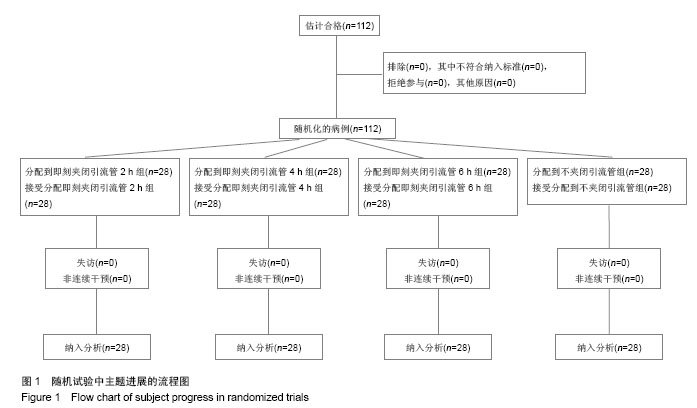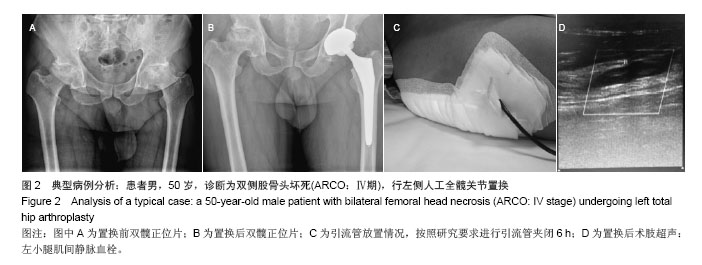| [1]荆鑫,滕红林,吴海山,等.全关节置换术后关节腔引流问题的探讨[J].中国矫形外科杂志,2002,10(z1):1295-1297.
[2]程薇.负压封闭引流术在创伤骨科的围手术期护理体会[J].医学临床研究,2012,29(4):791-792.
[3]Kim YH, Cho SH, Kim RS.Drainage versus nondrainage in simultaneous bilateral total hip arthroplasties.J Arthroplasty. 1998;13(2):156-161.
[4]陈志娜,黄少华,何瑾云,等.术后早期暂时夹管对全髋关节置换术后切口引流量的影响[J].中华护理杂志,2006,41(12): 1096- 1097.
[5]Brueggemann PM, Tucker JK, Wilson P.Intermittent clamping of suction drains in total hip replacement reduces postoperative blood loss: a randomized, controlled trial.J Arthroplasty. 1999;14(4):470-472.
[6]Hallstrom BR, Steele JF. Postoperative course after total hip arthroplasty: wound drainage versus no drainage. Orthop Rev.1992;21(7):847-51.
[7]Parker MJ, Roberts CP, Hay D.Closed suction drainage for hip and knee arthroplasty. A meta-analysis.J Bone Joint Surg Am. 2004;86-A(6):1146-1152.
[8]Walmsley PJ, Kelly MB, Hill RM,et al. A prospective, randomised, controlled trial of the use of drains in total hip arthroplasty.J Bone Joint Surg Br. 2005;87(10):1397-1401.
[9]Han CD, Shin DE.Postoperative blood salvage and reinfusion after total joint arthroplasty.J Arthroplasty. 1997;12(5): 511-516.
[10]Clements DH, Sculco TP, Burke SW,et al.Salvage and reinfusion of postoperative sanguineous wound drainage. A preliminary report.J Bone Joint Surg Am. 1992;74(5):646-651.
[11]Hungerford DS, Krackow KA.A convenient distal plug for the femoral cavity in total hip arthroplasty.Clin Orthop Relat Res. 1981;(154):329-330.
[12]Owens P, Lavernia CJ.Technique for a composite femoral intramedullary plug in cemented hip arthroplasty.J Arthroplasty. 1999;14(3):369-371.
[13]Sharrock NE, Salvati EA.Hypotensive epidural anesthesia for total hip arthroplasty: a review.Acta Orthop Scand. 1996;67(1): 91-107.
[14]Leegwater NC, Willems JH, Brohet R,et al.Cryocompression therapy after elective arthroplasty of the hip.Hip Int. 2012; 22(5):527-533.
[15]Mawatari M, Higo T, Tsutsumi Y,et al.Effectiveness of autologous fibrin tissue adhesive in reducing postoperative blood loss during total hip arthroplasty: a prospective randomised study of 100 cases.J Orthop Surg (Hong Kong). 2006;14(2):117-121.
[16]Brueggemann PM, Tucker JK, Wilson P.Intermittent clamping of suction drains in total hip replacement reduces postoperative blood loss: a randomized, controlled trial.J Arthroplasty. 1999;14(4):470-472.
[17]Hallstrom BR, Steele JF.Postoperative course after total hip arthroplasty: wound drainage versus no drainage.Orthop Rev. 1992;21(7):847-851.
[18]Zhou XD, Tao LJ, Li J,et al.Do we really need tranexamic acid in total hip arthroplasty? A meta-analysis of nineteen randomized controlled trials.Arch Orthop Trauma Surg. 2013; 133(7):1017-1027.
[19]Yamasaki S, Masuhara K, Fuji T.Tranexamic acid reduces postoperative blood loss in cementless total hip arthroplasty.J Bone Joint Surg Am. 2005;87(4):766-770.
[20]Johansson T, Pettersson LG, Lisander B.Tranexamic acid in total hip arthroplasty saves blood and money: a randomized, double-blind study in 100 patients.Acta Orthop. 2005;76(3): 314-319.
[21]戴晓倩,王红,陈莉莉,等.全髋关节置换术后时间引流量与拔管时间的相关性研究[J].临床外科杂志,2009,17(4):270-271.
|



.jpg)